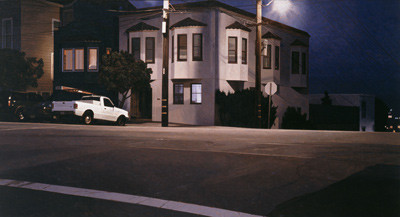The Wizard of Oz
02 Sep - 13 Dec 2008

20th and Mississippi - Night, 2005
Oil on canvas
37 1/4 x 67 1/4 x 1 7/8 in.
Courtesy Gladstone Gallery, New York.
Lower Gallery
Sept. 2–Dec. 13, 2008
The Wizard of Oz takes L. Frank Baum's popular novel The Wonderful Wizard of Oz as its starting point to examine the relationship between art and literature, our idea of home and place, as well as the cultural and social fabric of America itself.
PARTICIPATING ARTISTS: Robert Bechtle, Jennifer Bornstein, Ulla von Brandenburg, Bruce Conner, Walker Evans, Simryn Gill, Dominique Gonzalez-Foerster, Felix Gonzalez-Torres, Loris Gréaud, Joseph Grigely, Carsten Höller, Evan Holloway, Glenn Ligon, Steve McQueen, Gareth Moore, Rivane Neuenschwander, Raymond Pettibon, Clare Rojas, Harry Smith, Donald Urquhart, Andy Warhol, Cerith Wyn Evans
One of the best-known stories in American popular culture, The Wonderful Wizard of Oz marks the second in a series of exhibitions that curator Jens Hoffmann has developed which take a novel, a short story or other written narrative as a point of departure. The first in this series was Around the World in Eighty Days based on Jules Verne's classic, presented in 2006 at the Institute of Contemporary Arts and the South London Gallery, both in London.
Set in the heartland of America, in rural Kansas, at the turn of the twentieth century, The Wonderful Wizard of Oz tells the story of Dorothy, deposited by a tornado into a wondrous, strange and, at times, threatening land. With the help of her new companions, a scarecrow, a tin man and a cowardly lion, she advances along the yellow brick road to the emerald city, in her search for a way home.
Published in 1900, The Wonderful Wizard of Oz, captured a moment when American society was rapidly changing, due in part to industrial, political and technological advances, the women's movement, and increased expansion towards the west. Some of the themes that it touched upon, whether the realities of childhood, rural life, poverty, displacement and migration, as well as the more intangible, but nonetheless pervasive, ideas of security, friendship and dreams, continue to have resonance with the way that we experience not only the world but also how we approach an idea of America itself.
The aim of the exhibition The Wizard of Oz is to tell the story of the novel by translating the narrative of the book into the narrative of the exhibition including all its complex and multilayered meanings. The participating artists in the exhibition either present a new piece that has been especially conceived in response to the novel, or an existing work that relates to a theme or topic outlined by the narrative. The artworks on view encompass sculpture, film, video, drawing and photography and explore the serious and playful, notions of dislocation, home, utopia, fairies, mortality, machines, illusions, good vs. evil, witches, anxieties, family and poverty.
This exhibition also includes a large number of cultural artifacts, that have been created in response to the novel, including a first edition of Baum's The Wonderful Wizard of Oz, several of W.W. Denslow's original illustrations that accompanied the first Oz book, the first film version directed by Baum himself, and other curiosities, including, of course, the ruby slippers. A unique exhibition design that follows some of the elements of the original novel and the famous film adaptation of 1939, as well as a specially produced publication, will make The Wizard of Oz an unusual experience of how to analyze and exhibit contemporary art.
Lead sponsorship for The Wizard of Oz is provided by The Andy Warhol Foundation for the Visual Arts.
Founding support for CCA Wattis Institute for Contemporary Arts programs has been provided by Phyllis C. Wattis and Judy and Bill Timken. Generous support provided by the Phyllis C. Wattis Foundation, Grants for the Arts / San Francisco Hotel Tax Fund, Ann Hatch and Paul Discoe, and the CCA Curator's Forum.
